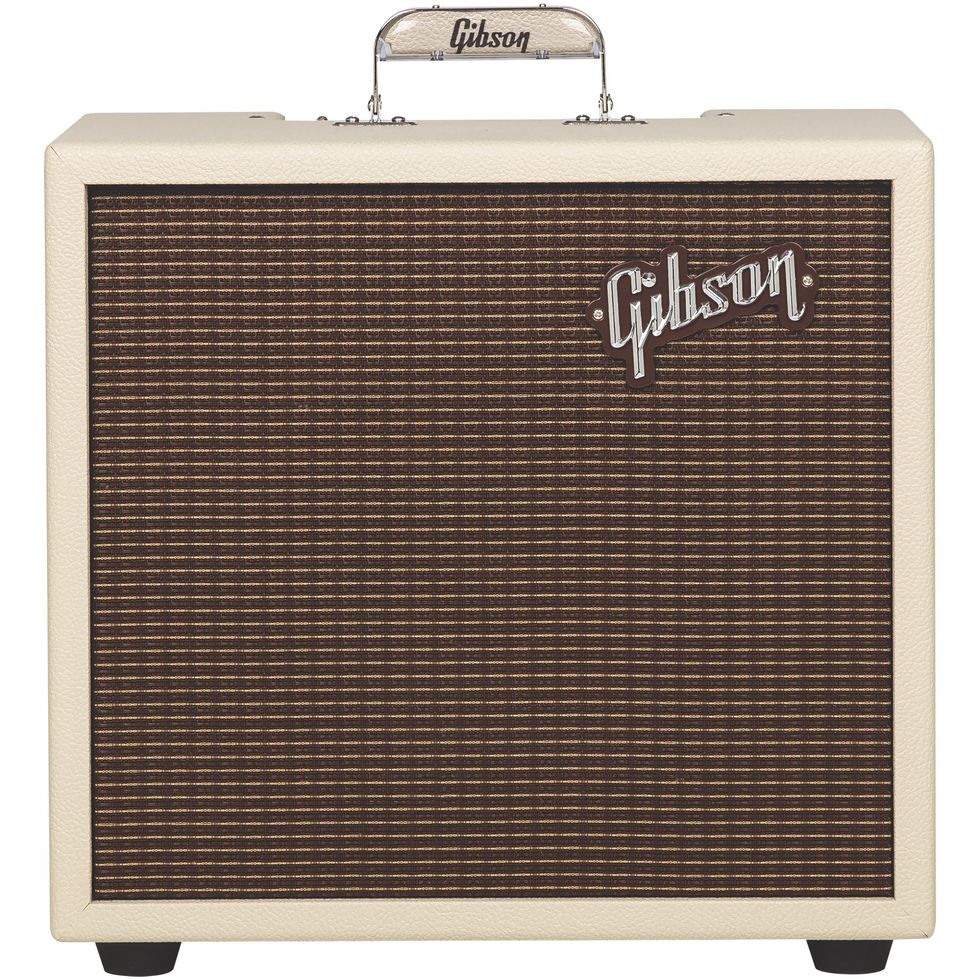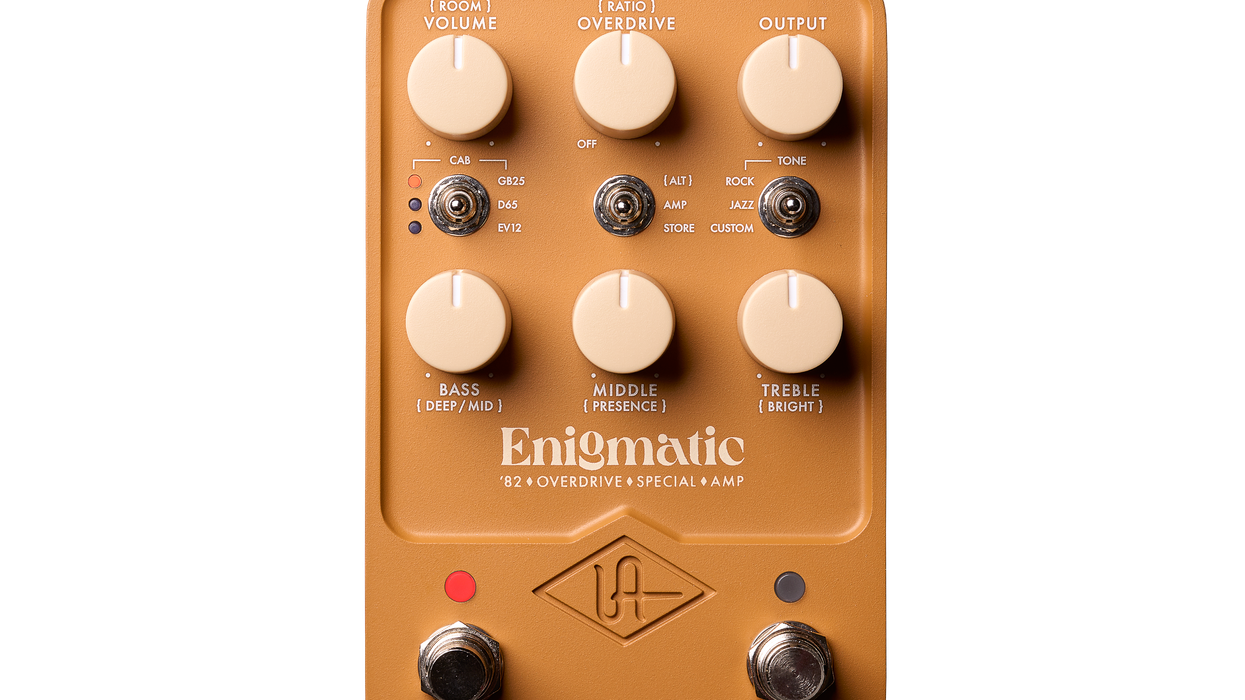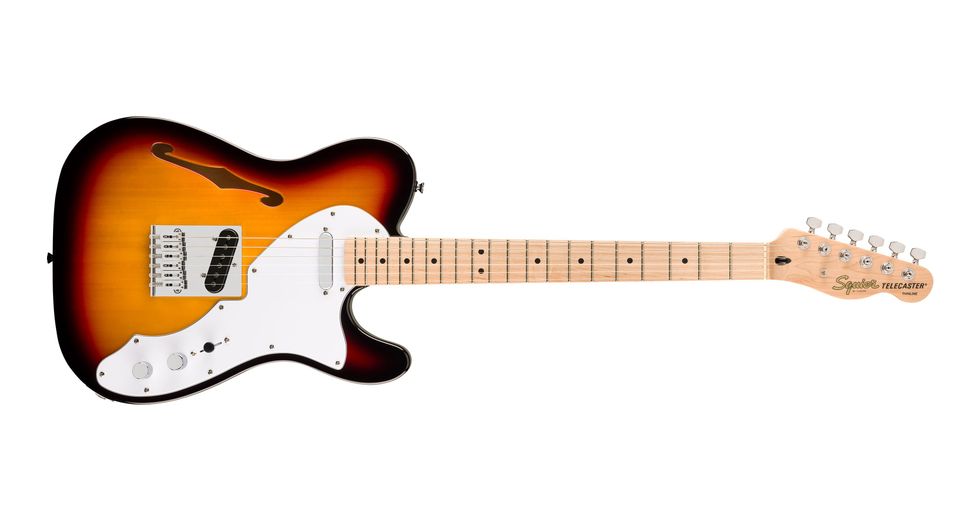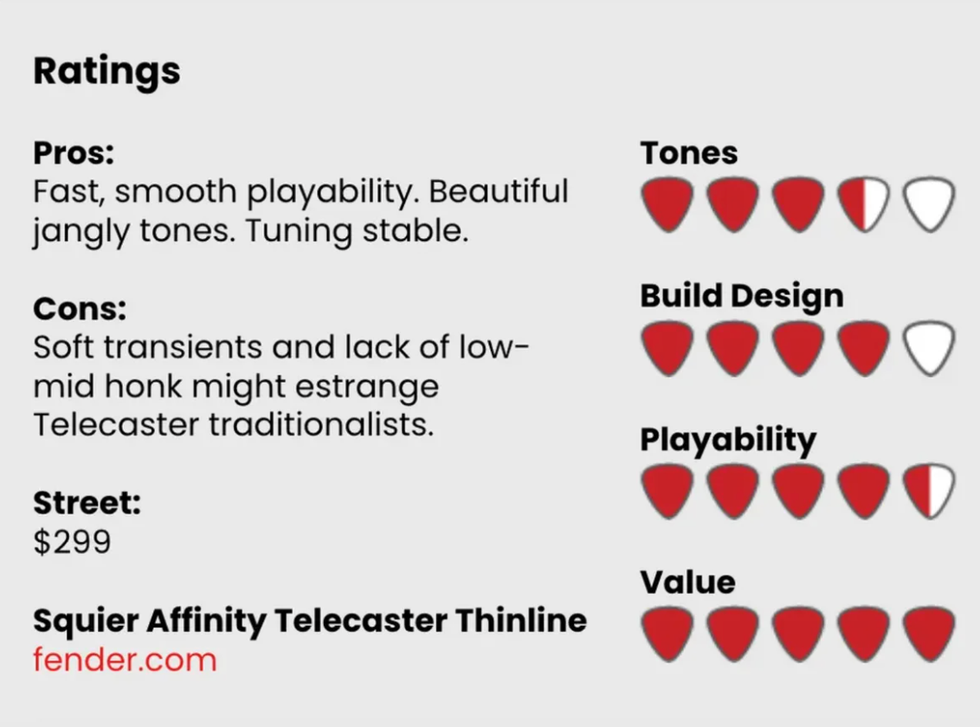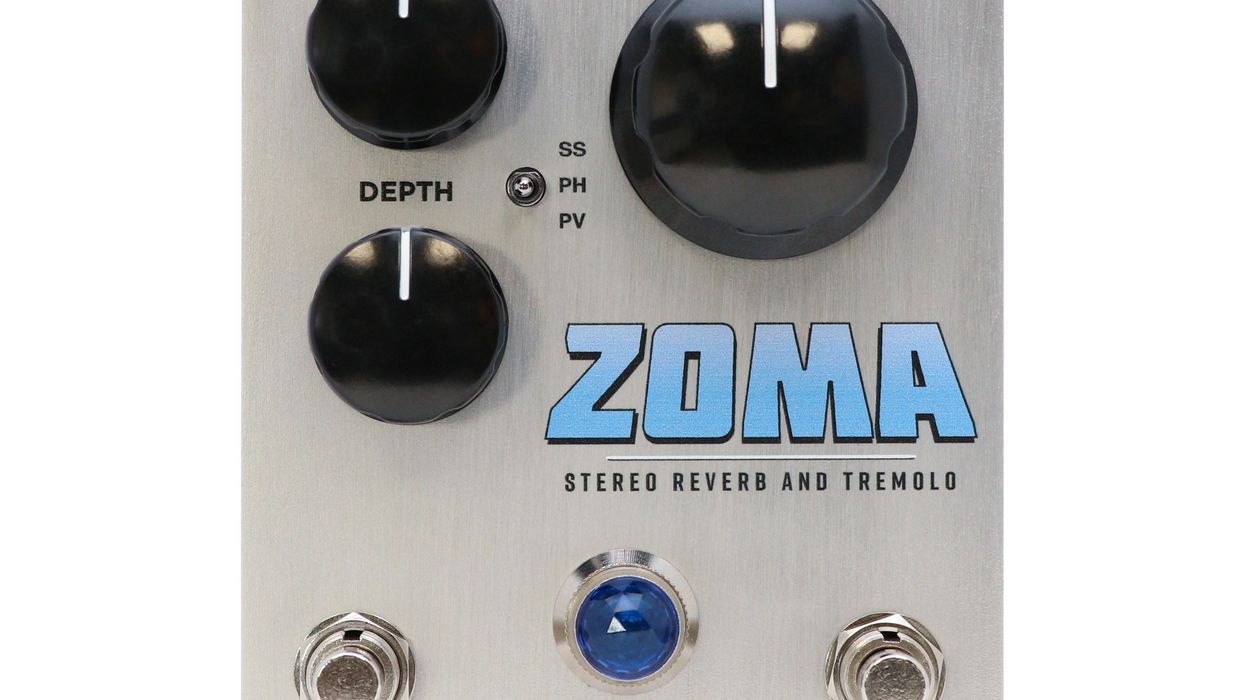I love old science fiction and horror movies, and one of my favorites is The Fly, both the Vincent Price and Jeff Goldblum versions. The premise: A scientist developing a teleportation machine accidentally steps into its chamber with a fly inside, and their genetic material gets blended. Mayhem ensues.
Gibson Falcon 20
But imagine if that scientist was teleporting a vintage amp, and accidentally left a high-end boutique amplifier at the back of the chamber? The result might be the reimagined Gibson Falcons, which combine the pleasures of old-school tone with the clarity, quality, robust punch—and some of the functionality—of a modern boutique amp.
I love the sound of low-wattage Gibson and Valco amps from the early 1960s, and original Falcons and Skylarks—the latter model inspired the Falcon 5—are classic examples. They have lush midrange, fat, elegant bottom-end, snappy high-string response (with a bit of top-end roll-off), and they break up beautifully. It’s a sound that’s perfect for blues and other rusty-tractor-style roots and rock. Just ask Ry Cooder. But vintage examples can have a little fog in their voices, which amounts to a lack of clarity—especially with brisk, heavy-handed chording. I used to think eliminating that patina would kill the vibe that made those amps special, and I had largely ascribed that patina to aged components and speaker dust, until I heard a mothballed NOS Gibson GA-20 that had the very same qualities. Thankfully, that fog is gone in these two canny birds.
Let's Boogie
The Gibson brand hasn’t appeared on an amp since 2008, although in 2021 the company did acquire Mesa/Boogie. So, it seems only natural that Mesa’s founder Randall Smith and R&D director Doug West would be involved in resurrecting these avians, which are built in Mesa’s Petaluma, California, shop.
The only outward signs of Boogie in these amps’ bloodstreams is the power-scaling toggles on the control panels and the monitor and 4-ohm outs on the rear panels. The Falcon 20 also scales between 1, 5, or 12 watts (or 2, 6, or 15 watts, with 6L6 tubes rather than the 6V6s in our test model), and the Falcon 5 can flip from 3 to 7 watts with its 6V6s, or 4 to 8 with 6L6 replacements. The 20 has a 12" Jensen Blackbird alnico speaker, while the 5 has a 10" Blackbird. They are serious sound generators.
While power-scaling has become common, Smith was a pioneer. “I really enjoyed the Falcon project, as it harkened back to my early days in the late ’60s as a repairman— becoming the first boutique amp builder before that category existed,” Smith told me, when queried about the reissues. “I could try out radical ideas on a small scale, in response to what players were seeking, like separating gain and distortion from playing loudness, and providing switchable power levels to fit different venues.”
Playing through both amps with a Les Paul, a Flying V, a PRS SE Silver Sky, and a custom Zuzu with coil-splitting, it readily became apparent that power-scaling wasn’t Smith and West's only renovation here. With each instrument, notes and chords were tightly focused—even with my raucous Tone Bender clone. Overtones hung in the air, the mids and lows were fat and present (even with the Falcon 5) with just the right amount of sag, and that light, distant fog that colors the originals was supplanted by clean, well-defined tones—all without sacrificing the essence of the classic sound I associate with old, small Gibson combos. The adjectives punchy, clear, beefy, airy, and responsive filled my head every time I plugged in.
The Gauntlet
To challenge these Falcons, I played them against character on gigs, bringing the 20 to a quiet room and the 5 for a loud rock set. For the low volume gig, I left the 20’s power full and turned down the volume. Not an iota of its character was diminished. And the 5 was a barking wonder, cranked up to noon, with its humble 10" speaker maintaining clarity and focus and characterful tones despite the incursions of my drive, fuzz, delay, and modulation pedals—proving it’s far more than a practice amp. I’d play either Falcon anywhere, without reservations. And at home, the amps managed to maintain their essential personalities at all power settings.
Smith offers an explanation: “What I did in resurrecting the Falcons was retain parts of the circuit that contributed to its character while getting creative with my bag of experience to make it a hot rod instead of a reproduction. Doug and I auditioned different capacitors and resistors to get vintage characteristics, but the power and output transformers were custom-designed and refined”—the key to the amps’ sounding both old and new at once.
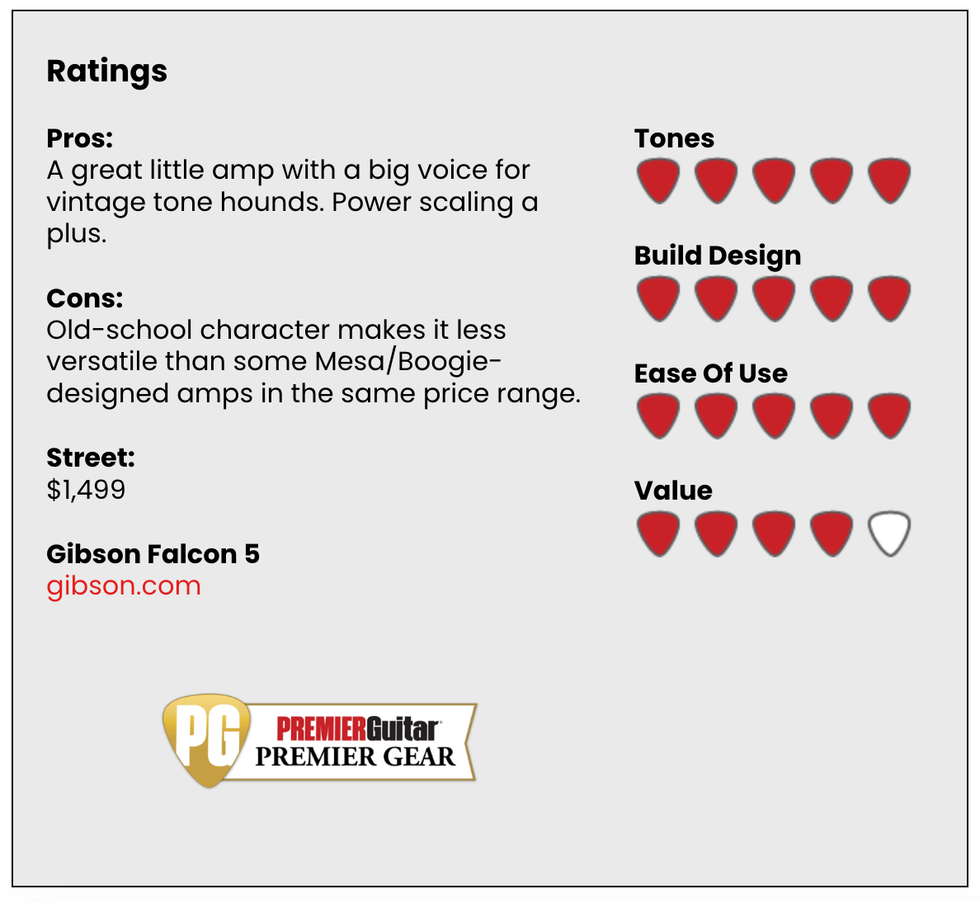
There’s no mystery to the Falcon’s controls. The 5 is dirt simple, just like original Skylarks. There are two inputs, power and standby toggles, and volume, tone, and reverb dials. On the 20, there’s all of that plus depth and frequency dials for the tremolo, and an included on/off pedal for tremolo and reverb.
The tremolo on the Falcon 20 is a bit too subtle for my taste, but it’s a sore spot for me with the originals, too. If I want to use an effect, I really want to hear it, and unless the depth control is close to noon and higher, it's not terribly effective on the Falcon. That said, there are pleasing, colorful tremolo textures to be found in the upper half of the depth’s range, particularly with frequency settings ranging from 10 o’clock to near maximum. This tremolo isn’t about extremes; it's about mood and vibe. Unfortunately, at high depth settings—say, after 5 o’clock—the pulses get noisy. That’s likely because the tremolo is part of the power section. And that’s an unfortunate trait of vintage examples, too.
The spring reverb on both Falcons, however, is perfect and perfectly vintage to my ears. It’s comparable to that on my own ’64 Supro Tremo-Verb, but with a wider range and glorious depth. It made my guitar sound warm and glowing, or, when I wanted to crank the reverb up, like a flashback from the original psychedelic era or a ’60s Chess session. It sounds almost otherworldly at maximum. I basked in its warmth and weirdness. Smith, again, shares his strategy: “The original Falcons were the very first guitar amps to incorporate reverb and did it in a way that we consider to be unconventional now. One could literally turn up the reverb while keeping the dry guitar signal completely off. But it was new technology at the time, which later evolved. I retained the original input, tremolo, and power amp circuitry, but the reverb was, again, more of a hot-rod approach.”
The Verdict
These small, easy-to-lift combos are loud, clear, and bold, and dialing in great sounds is easy. Dressed up in cream bronco vinyl and plastic handles showing the Gibson name inside them, they transmit old-school vibe as they provide updated takes on classic tones. They‘re also a cheaper, more efficient option than actual vintage Skylarks or Falcons, which fetch high prices these days. For their blend of modern efficiency and reliability, and classic tones, these birds certainly soar.

